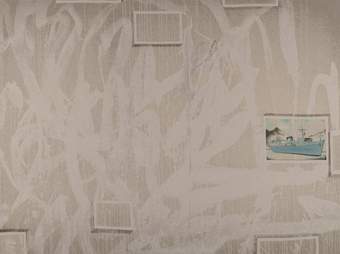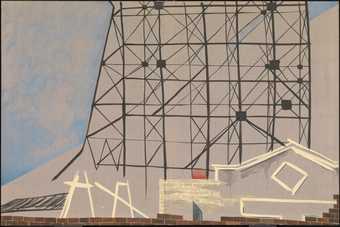I went to New York about two years ago and the Arthur Kennedy came from that, it was actually just the view outside my window. I wanted to just work and not think about anything else, so everything that I had collated and looked at and, you know, I experienced, I suppose, and then put that together with what I was thinking about.
But how can you make something that is flat against the wall take up space, in a way, and get somebody involved in that?
When I first started painting again I thought a lot about sculpture and about buildings and spaces. I do quite a bit of research in advance. When I feel that I鈥檝e, sort of, reached a point where I can鈥檛 do any more research I just start painting. The actual time painting is relatively small. I have an idea, a vague idea or maybe even a clear idea but the painting is never, it鈥檚 resolved within the process of actually doing it. And you never know what the result鈥檚 going to be so that鈥檚 the, sort of, the pleasure of making it.
For this particular, sort of, series of paintings I鈥檝e been looking at some photographs that I took in Holland and I noticed that the window displays have these very, sort of, twee pairings of vases or statues or plants. And there is that, sort of, history in Dutch painting of this window display, they never have curtains and everything is just open for people to look at and they seem quite proud of it. So I wanted to make this series of paintings from these photographs. And, you can鈥檛 really tell whether you鈥檙e inside or outside or where the line is of, the sort of, the territory line, I suppose, the borderline. Again, they become like these unreadable vignettes where you鈥檙e just plucking elements of it.
There鈥檚 no primer on the canvas but I always hated that, when you had to, sort of, get rid of the surface. So I chose to work on linen because it was like having a piece of paper, you just, sort of, start and start the drawing and I ignore it but it seems to unify the work for some people.
I was trying to interrupt those ways of reading something visual that we recognise, trying to, sort of, break down that visual recognition in a way so that you鈥檙e interrupted and you have to get involved.
Yeah, you know when they鈥檙e finished. You just get to the point where you can鈥檛 do any more and the painting tells you it鈥檚 finished or unfinished.
They require some imagination or people, you know, willing to use their imagination, and that鈥檚 always quite risky I think. People are scared of what they don鈥檛 know or what they think they should understand. Who wants to look at this static image that鈥檚 not necessarily giving you what you want immediately? It requires a lot of generosity, I think, from the point, part of the viewer.


